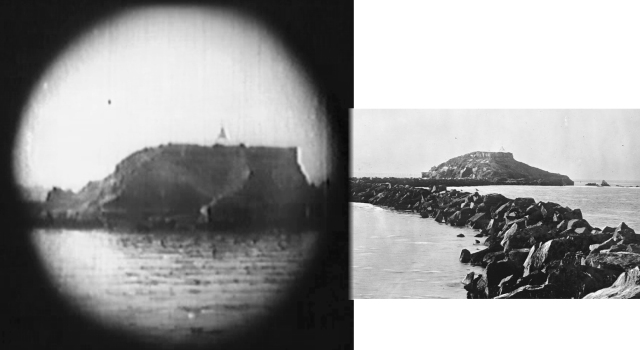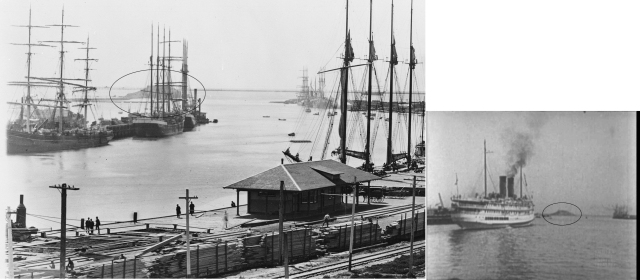It sounds like an adventure befitting Indiana Jones, but in the waning days of 1916 Harold Lloyd filmed his sixth “Lonesome Luke” production on Deadman’s Island near San Pedro. Rising up from the extreme tip of Terminal Island, the spectral rock was a prominent early California landmark guiding sailors into Los Angeles Harbor.
Lloyd’s production was called Lonesome Luke’s Wild Women, and involved Harold and Snub Pollard being shipwrecked on an island occupied by a Shah and his harem of wives. Though not widely distributed today, the film provides a fascinating historical record of this once familiar setting, and may be the only extant movie footage of this now lost geologic feature.
In his 1840 classic Two Years Before the Mast, Richard Henry Dana, Jr. describes Deadman’s Island in great detail, and how the previously unnamed island came to be known as La Isla de los Muertos. Dana visited San Pedro in 1835, and the beachfront community Dana Point fifty miles to the south is named in his honor. Dana writes as follows:
“[T]he only … thing which broke the surface of the great bay was a small, dreary-looking island, steep and conical, of a clayey soil, and without the sign of vegetable life upon it, yet which had a peculiar and melancholy interest, for on the top of it were buried the remains of an Englishman, the commander of a small merchant brig, who died while lying in this port. It was always a solemn and affecting spot to me. There it stood, desolate, and in the midst of desolation; and there were the remains of one who died and was buried alone and friendless. Had it been a common burying-place, it would have been nothing. The single body corresponded well with the solitary character of everything around. It was the only spot in California that impressed me with anything like poetic interest. Then, too, the man died far from home, without a friend near him,— by poison, it was suspected, and no one to inquire into it,— and without proper funeral rites; the mate (as I was told), glad to have him out of the way, hurrying him up the hill and into the ground, without a word or a prayer.”
Early map showing Deadman’s Island – Rattlesnake Island would be built up and become known as Terminal Island – Los Angeles Public Library SPNB Collection
A few years later, in October, 1846, six American marines from the U.S.S. Savannah, who were killed or died of wounds in the fight at Dominguez ranch, when Mexico successfully expelled the United States’ occupying forces from Los Angeles, were also buried on the island, expanding its mystique as the Isle of the Dead. Following accelerated erosion and deterioration on the island, their remains were removed many years later to military cemeteries in San Pedro, and in the Presidio in San Francisco.

The natural arch on Deadman’s Island – Lonesome Luke’s Wild Women at left, USC Digital Archive California Historical Society
In 1916, the year Harold shot his movie, the United States War Department relinquished its 60-year control of the island to the Department of the Treasury, which planned to flatten and enlarge the site for a quarantine station, and officially christened the site with the decidedly unromantic name “Reservation Point” that appears on maps of that era.
Projecting halfway across the mouth of the harbor channel, the island posed a navigation hazard to large ships, and was excavated and dredged into oblivion during the years 1927 to 1929. The fill removed from the island was deposited to the east, away from the channel, reclaiming a parcel equal to what was lost. Long-rumored to be a secret base for Prohibition rum-runners, and home to buried treasure, even in death Deadman’s Island lived up to its sinister reputation. The Los Angeles Times reports the suction drudge dismantling the island brought forth three redwood caskets each containing skeletal remains, and that tragically two dredge-men were killed during the island’s destruction.
Deadman’s Island makes cameo appearances in other silent comedies. Lloyd filmed one of his early Glass Character shorts, a stowaway comedy entitled All Aboard (1917), at San Pedro Harbor, where the island appears in the background.









Fascinating post. Thanks! According to Wikipedia, here are the GPS coordinates for where the island once existed, http://goo.gl/maps/ovbk
LikeLike
Thanks Scott – I’ve posted it.
LikeLike
Amazing history and images. Excellent work!
LikeLike
Thanks Robby – the goal of this blog is to supplement the major discoveries that appear in my books. This movie is not commercially available, and there was no room to cover it in my book. So it’s fun to give it a lengthy treatment here.
LikeLike
Amazing work, as usual, John. Loved this post! I was intrigued by Deadman’s Island since I first read Dana some years ago. Also Terminal Island, which I guess used to have some nice beach homes on it in the first years of the 20th Century. Totally different now. Any film locations there? Your blog keeps getting better and better!
LikeLike
Pingback: Links – May 4, 2013
I represent the frigate USS UNITED STATES, First Ship of the United States Navy. During a cruise returning to Washington, 1842-1844, she sailed from Hawaii. There is a report that the remains of a ship’s steward died and was buried on “Deadman’s Island” in a shallow grave. However, it only refers to Mazatlan in Mexico. (BTW Herman Melville, author of Moby Dick served on board her as an Ordinary Seaman). There are at least 5 Deadman’s Islands that I know of. But no-one knows where it is near Mazatlan. Still looking for his remains.
Ed. Zimmerman, Jr.
USS UNITED STATES Foundation
USSUNITEDSTATES@GMAIL.com
LikeLike
Thank you for this information. Good luck with your investigation. John
LikeLike
John- Hi- I just retired after being director of the Port of LA for the past eight years. I am also working on a book to be published by Angel City Press called Terminal Island, the Lost Communities of Los Angeles Harbor. It covers the period when the island had residential communities on it, from the first hermit fisherman in the 1870’s when it was called Rattlesnake Island through the resort era and concluded with the Japanese community that was there until WWII. Deadman’s island is also included as it became part of Terminal Island. Your post provided some new information that we are including. I see you say the Lloyd’s film is not commercially available. is there anyplace the movie can be viewed? Geraldine Knatz
LikeLike
I sent you a private reply about the film – thanks, John
LikeLike
Hi- I would also love to find out where the film could be viewed- is it at the USC film archives or Pacific Film Archives?
LikeLiked by 1 person
My father use to take us to pier point landing on terminal island they had a little carnival there the restaurant’s were perched over the water all the old dock workers took there family’s there
LikeLike
Cool – thanks for sharing Steve
LikeLike
Pingback: Bringing Weatlh and Water to the City of Angels: Transforming Los Angeles’ physical landscape into an Anglo Vision 1908-1960 – The Toro Historical Review
Pingback: The islands of L.A. Harbor: Dead Man’s Island and Rattlesnake Island | South Bay History